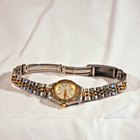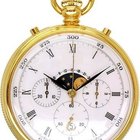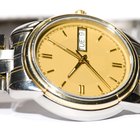Watches operate using a variety of mechanisms. Whether automatic, winding or quartz, steps must be taken to ensure the piece continues to run as expected. One sign of improper maintenance is the presence of a stalled second hand. Typically, the reason for this is that the watch has run out of energy, either from the quartz battery or an unwound mainspring.
Self-winding
Strap the watch on your wrist as normal. Ensure the piece is firmly attached, without exhibiting too loose a fit. Ideally, you should be able to fit your finger between your wrist and the back of the watch.
Rotate the watch on your wrist, as through you were swirling a glass of wine. Repeat 40 to 50 times.
Check for movement from the second hand. Set the time and date if necessary, following the watch maker's instructions.
Manual Winding
Pull out the crown on the side of the watch to the first position. Unscrew the crown counter-clockwise, if necessary, until it spins freely.
Rotate the crown upward repeatedly. Stop when you feel significant resistance. Do not attempt to wind the watch beyond this point.
Screw or push the crown back to re-seal the case. Observe the second hand for proper clockwise movement.
Quartz
Flip the watch over onto a soft yet firm surface. Locate the notches around the case back.
Place the case back opener around the indentations on the case back. Firmly grip the opener, rotating the tool counter-clockwise.
Set the case back aside. Locate the battery, typically placed under a small silver-toned retaining clasp.
Insert the tip of a small flat head screwdriver under the notch to one side of the battery.
Pop the battery out. Slide in the new battery under the retaining clasp. Screw the case back on tightly, using the opener tool.
Related Articles

How to Tell if a Waltham Watch is ...

How to Adjust a Movado Watch

Pulsar Chronograph Watch Instructions

How do I Replace a Battery in a Men's ...

How to Change the Date on a Luminox 3080

How to Get the Back Off a Burberry Watch

How to Replace Seiko Watch Bands

How to Replace a Nike Triax 50 Battery

How to Set a Skagen Watch

How to Evaluate Invicta Watches

How to Change the Battery in a Cartier ...

How to Set the Time on a Rolex Daytona

How to Reset the Luminox Chrono Sweep

How to Open a Waterproof Watch Case

The Manufacturing Process of a Watch

How to Remove a Rolex Oyster Perpetual ...

How to Replace the Bezel on a Rolex ...

How Does a Pocket Watch Work?

How to Remove a Stuhrling Watch Band

Tools for Removing the Back of a Watch
References
Writer Bio
David Lipscomb is a professional writer and public relations practitioner. Lipscomb brings more than a decade of experience in the consumer electronics and advertising industries. Lipscomb holds a degree in public relations from Webster University.